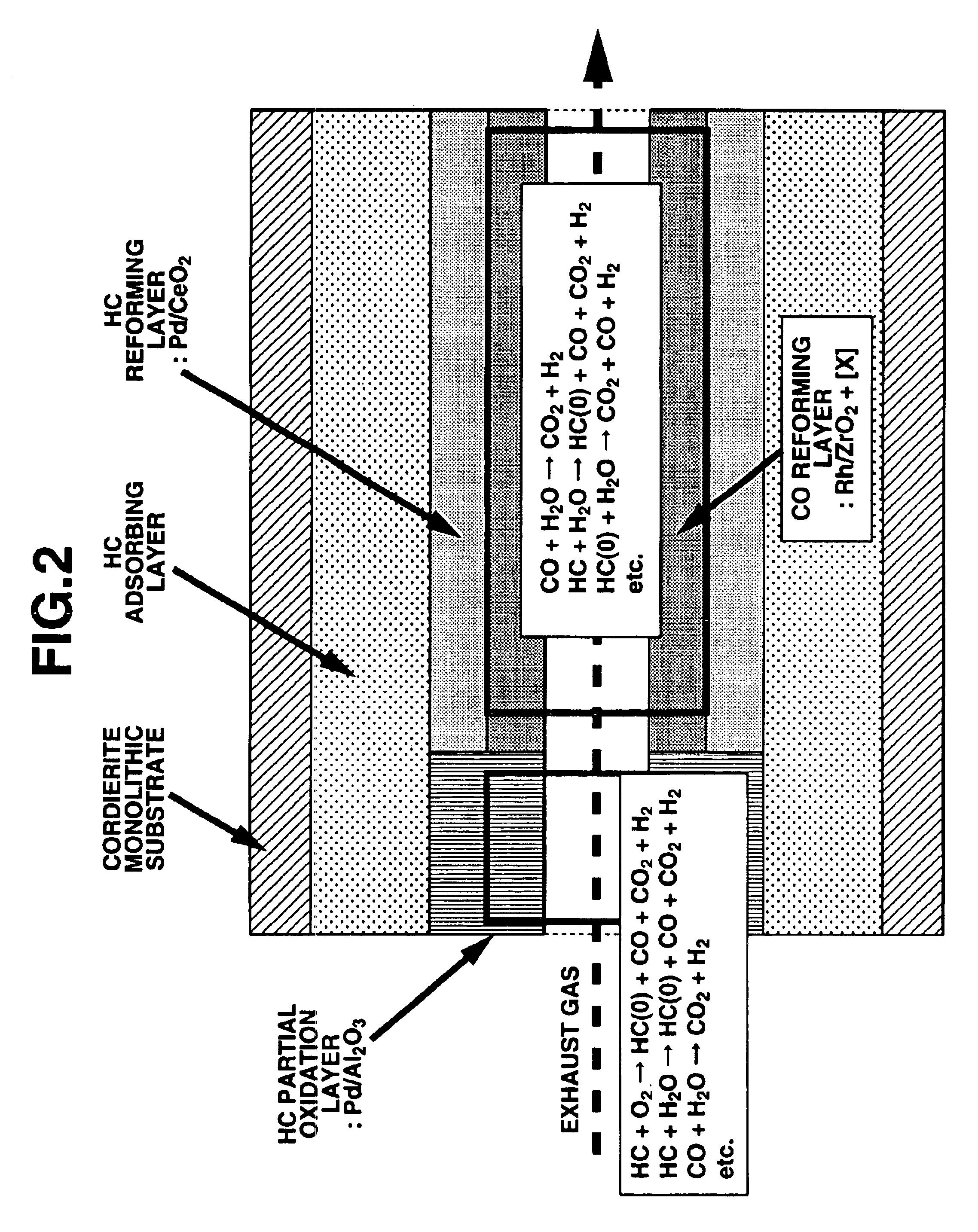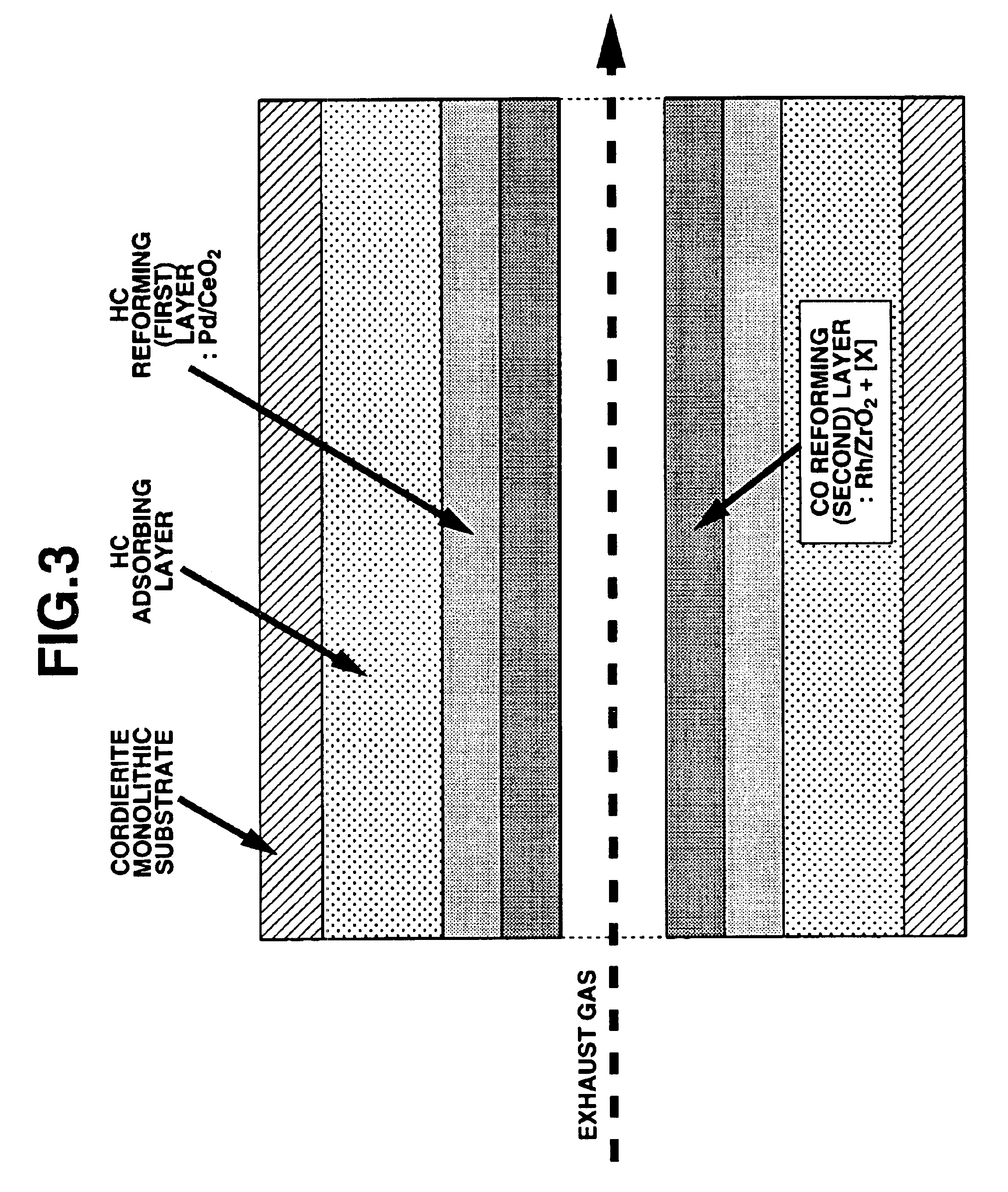Exhaust gas purifying catalyst
a technology of exhaust gas and purifying catalyst, which is applied in the direction of physical/chemical process catalysts, metal/metal-oxide/metal-hydroxide catalysts, and separation processes, etc., can solve the problem of unavoidable lowering of the temperature of the exhaust gas flown to the catalyst, inability to obtain the fuel economy improvement effect, and inability to achieve the effect of fuel economy improvemen
- Summary
- Abstract
- Description
- Claims
- Application Information
AI Technical Summary
Benefits of technology
Problems solved by technology
Method used
Image
Examples
example 1
Preparation of Catalyst
[0071]β-Zeolite (Si / 2Al=25) in an amount of 900 g was mixed with 100 g of silica sol and 1000 g of pure water, followed by pulverizing, thereby forming a slurry. The slurry was coated on a cordierite ceramic honeycomb-type monolithic substrate having a volume of 1.3 liters and 900 cells per square inch and having a thickness of walls (defining each cell) of 4 mil, so that the walls of the cells were coated with the slurry. The thus coated substrate was dried and then fired thereby to obtain a catalyst Z1 having 100 g of a zeolite coat per one liter of the monolithic substrate.
[0072]Subsequently, 706 g of the powder A, 14 g of nitric acid-acidic alumina binder and 800 g of pure water were mixed and pulverized thereby forming a slurry. The slurry was coated on the catalyst Z1, so that the walls of the cells were coated with the slurry. The thus coated catalyst was dried and fired thereby to obtain a catalyst A provided with a coat formed on the catalyst Z1 and h...
examples 2 to 7
Preparation of Catalyst
[0078]Catalysts AG2, AG4, AG5, AG6 and AG7 (shown in Table 2) corresponding respectively to Examples 2, 3, 4, 5, 6 and 7 were obtained repeating the above preparation operation for the catalyst AG1 with the exception that β-zeolite (Si / 2Al=25) was replaced with other HC adsorbing materials shown in Table 2, respectively.
[0079]In the column of “HC adsorbing layer” in Table 2, “β(Si / 2Al=15)” indicates the fact that the HC adsorbing layer contained β-zeolite (having a Si / 2Al ratio of 159; “β(Si / 2Al=300)” indicates the fact that the HC adsorbing layer contained β-zeolite (having a Si / 2Al ratio of 300); “β(Si / 2Al 25)+MFI (=30)” indicates the fact that the HC adsorbing layer contained a mixture of β-zeolite (having a Si / 2Al ratio of 25) and MFI (having a Si / 2Al ratio of 30); “β(=25)+USY(=15)” indicates the fact that the HC adsorbing layer contained a mixture of β-zeolite (having a Si / 2AI ratio of 26) and USY-type zeolite having a Si / 2Al ratio of 15); “Ag, P-β(=25)” ...
example 8
Preparation of Catalyst
[0081]β-Zeolite (Si / 2Al=25) in an amount of 900 g was mixed with 100 g of silica sol and 1000 g of pure water, followed by pulverizing, thereby forming a slurry. The slurry was coated on a cordierite ceramic honeycomb-type monolithic substrate having a volume of 1.3 liters and 900 cells per square inch and having a thickness of walls (defining each cell) of 4 mil, so that the walls of the cells were coated with the slurry. The thus coated substrate was dried and then fired thereby to obtain a catalyst Z1 having 100 g of a zeolite coat per one liter of the monolithic substrate.
[0082]Subsequently, 706 g of the powder B, 14 g of nitric acid-acidic alumina binder and 800 g of pure water were mixed and pulverized thereby forming a slurry. The slurry was coated on the catalyst Z1, so that the walls of the cells were coated with the slurry. The thus coated catalyst was dried and fired thereby to obtain a catalyst B provided with a coat formed on the catalyst Z1 and h...
PUM
| Property | Measurement | Unit |
|---|---|---|
| Fraction | aaaaa | aaaaa |
| Fraction | aaaaa | aaaaa |
| Fraction | aaaaa | aaaaa |
Abstract
Description
Claims
Application Information
 Login to View More
Login to View More - R&D
- Intellectual Property
- Life Sciences
- Materials
- Tech Scout
- Unparalleled Data Quality
- Higher Quality Content
- 60% Fewer Hallucinations
Browse by: Latest US Patents, China's latest patents, Technical Efficacy Thesaurus, Application Domain, Technology Topic, Popular Technical Reports.
© 2025 PatSnap. All rights reserved.Legal|Privacy policy|Modern Slavery Act Transparency Statement|Sitemap|About US| Contact US: help@patsnap.com



